- Joined
- Nov 16, 2012
- Messages
- 5,596
Several people are getting into surface grinders so, I'll post some experiences with making a balancing grinder hub. Even though I haven't finished the turret tailstock, I'll start posting some of the photos of prior work so interested folks can get a move on it.
It's more tricky than you might imagine and I had to screw it up 2 times before finding the right sequence of operations for it to come out properly. An experience machinist might have less problems and I'm open to suggestions. The critical part is concentricity of the tapered bore WRT the outer spindle diameter that the wheel goes onto. The taper angle must be perfect -no room for error and if that concentricity is not within +/- 0.00025, there's no hope for it for precision grinding. Mark it and only use it for coarse grinding. The wheel cylinder part must be 1.2495 +0.0003 -0.0000. The backing plates can be off a little (+/- a thou) because the buffer pads will absorb the error.
Here are some starter photos and explanations.
Here's a finished product that is not yet heat treated but is otherwise finished. I've been using it for a few months now. Shown is the backside with the dual balancing weights. Those weights must be secured properly and the circular groove must have adequate depth to ensure a good fit. CAUTION: Never use any grinding wheel without a safety cover. My safety cover is home made and has a front door that covers the front of the wheel. -And for the record, the balancing mechanism here is nothing new; this design has been around for many years. Although you can't see it in the photo, there is a circumferential groove that the cap screw fits into to aid secure attachment. Also shown is the locking nut as well as a view of a mounted wheel. Of course, you'll need to make a spanner wrench. -And don't forget to use all left-hand threads if your machine spins in the clockwise direction while facing it from the front.
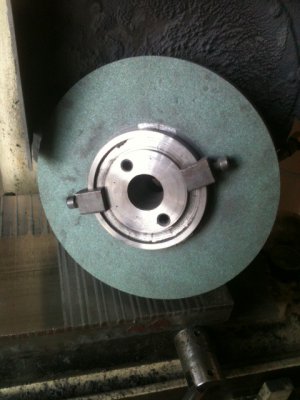
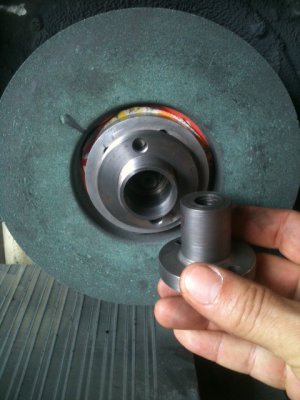
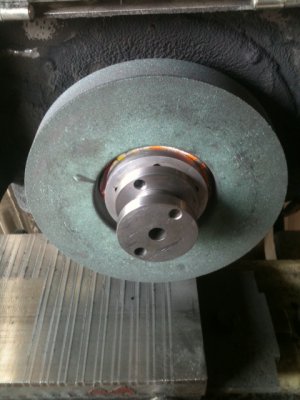
The wheel must be balanced prior to spin-up. You'll need to make an off-site balancing arbor and balancing apparatus such as this. It mimics the SG spindle shaft. This is one of those projects where you need to make a lot of parts just to make the part... Anyhow, you mount a wheel on the hub without the balancing weights, put it on the balancing apparatus, find the heavy side and place the weights equally on the opposite side of the heavy end. The balancing weights are just some milled pieces of metal with a cap screw.
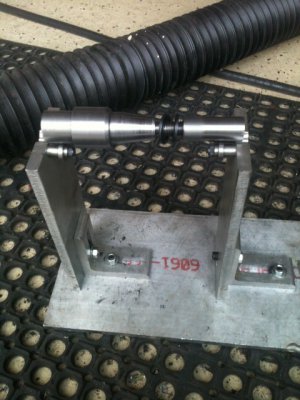
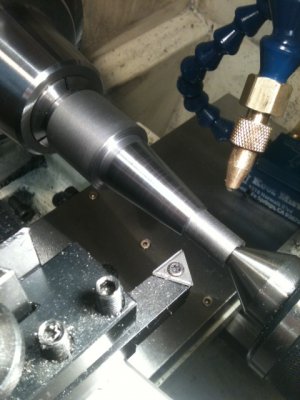
Here's a raw hub. I make them from two pieces to save materials and a lot of swarf clean-up. It's 1045 and was welded in the raw HR condition then, fully stress relieved and soft annealed. When it comes time to lathe these down to size, those weld caps will come off like butter.
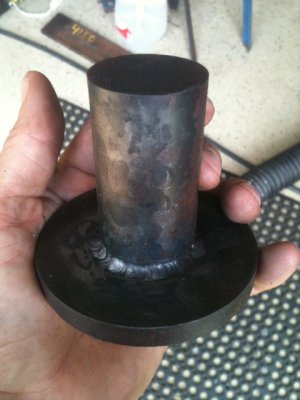
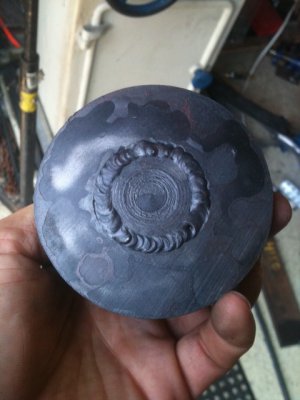
Here's a piece of O1 heat treated to 60 RC and was my attempt at making a parallel bar. It's pretty good and I use it a lot for different things. If the SG hub is not perfect, every wobble it induces in the wheel will show-up in the grind piece. This particular grind came-out OK. I'm still practicing and teaching myself how to use a grinder. There is almost no information out there on how to use one...
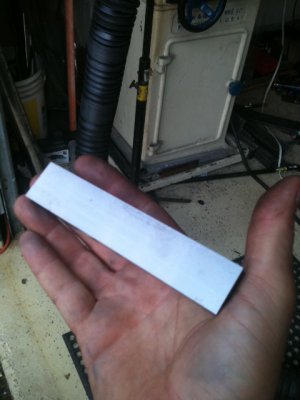
OK, that's it for now. We'll pick-up on this later. I'll cover the sequence of operations starting from the raw hubs and will also include how I made a taper reamer.
Ray








It's more tricky than you might imagine and I had to screw it up 2 times before finding the right sequence of operations for it to come out properly. An experience machinist might have less problems and I'm open to suggestions. The critical part is concentricity of the tapered bore WRT the outer spindle diameter that the wheel goes onto. The taper angle must be perfect -no room for error and if that concentricity is not within +/- 0.00025, there's no hope for it for precision grinding. Mark it and only use it for coarse grinding. The wheel cylinder part must be 1.2495 +0.0003 -0.0000. The backing plates can be off a little (+/- a thou) because the buffer pads will absorb the error.
Here are some starter photos and explanations.
Here's a finished product that is not yet heat treated but is otherwise finished. I've been using it for a few months now. Shown is the backside with the dual balancing weights. Those weights must be secured properly and the circular groove must have adequate depth to ensure a good fit. CAUTION: Never use any grinding wheel without a safety cover. My safety cover is home made and has a front door that covers the front of the wheel. -And for the record, the balancing mechanism here is nothing new; this design has been around for many years. Although you can't see it in the photo, there is a circumferential groove that the cap screw fits into to aid secure attachment. Also shown is the locking nut as well as a view of a mounted wheel. Of course, you'll need to make a spanner wrench. -And don't forget to use all left-hand threads if your machine spins in the clockwise direction while facing it from the front.



The wheel must be balanced prior to spin-up. You'll need to make an off-site balancing arbor and balancing apparatus such as this. It mimics the SG spindle shaft. This is one of those projects where you need to make a lot of parts just to make the part... Anyhow, you mount a wheel on the hub without the balancing weights, put it on the balancing apparatus, find the heavy side and place the weights equally on the opposite side of the heavy end. The balancing weights are just some milled pieces of metal with a cap screw.


Here's a raw hub. I make them from two pieces to save materials and a lot of swarf clean-up. It's 1045 and was welded in the raw HR condition then, fully stress relieved and soft annealed. When it comes time to lathe these down to size, those weld caps will come off like butter.


Here's a piece of O1 heat treated to 60 RC and was my attempt at making a parallel bar. It's pretty good and I use it a lot for different things. If the SG hub is not perfect, every wobble it induces in the wheel will show-up in the grind piece. This particular grind came-out OK. I'm still practicing and teaching myself how to use a grinder. There is almost no information out there on how to use one...

OK, that's it for now. We'll pick-up on this later. I'll cover the sequence of operations starting from the raw hubs and will also include how I made a taper reamer.
Ray








